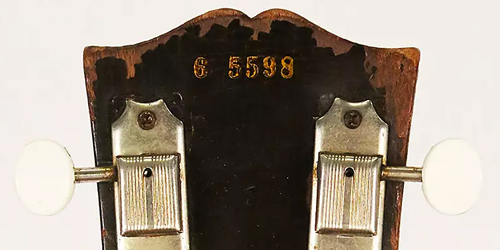Gibson Serial Number Lookup Search Decoder - How to date Vintage and New Gibson Guitars - SCROLL DOWN FOR YOUR YEAR!
We also have MANY Gibson Guitars for sale:
https://www.essexrecordingstudios.com/collections/gibson
Dating Gibson Headstock Logos Through The Decades
1902 to Late-1920s
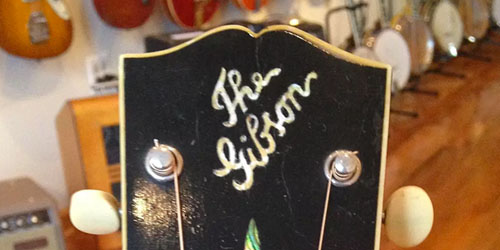
1923 Style O Artist
The original logo featured the words "The Gibson" inlaid in pearl at a slant, with an almost hand-written cursive font. This is sometimes referred to as the slanted script logo.
Some earlier specimens from 1903 to 1907 did not slant the logo, or went without a logo entirely. Specimens built before 1902 had a star inlay or crescent in place of a logo.
Late-1920s to 1933

1932 L-2
The script logo continues without the slant. Some flattop guitars of this era started to omit the word "The" from the inlay.
1933 to 1947
By 1933 Gibson had dropped the "The" from all of their logos while retaining the script "Gibson." The original thin script was replaced with a thicker font on higher-end models in the mid-’30s, and across the entire lineup by the end of the decade.

1934 L-5
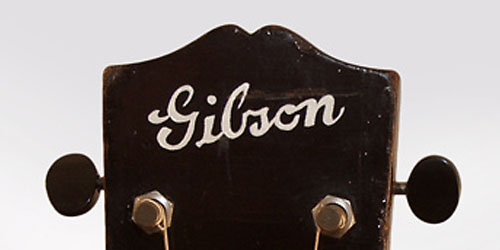
1935 J-35

1943 J-45
From 1943 to 1947, the logo was a thick golden script, known as the banner logo. Some models (LG-2, J-45, SJ, select L-50s) included an actual banner reading "Only a Gibson Is Good Enough" in the middle of the headstock.
1947 to Present
The block logo debuted after WWII and remains the face of the company. There were minute changes to which letters were connected in the font between 1961 to 1981, but the main logo had the same look.
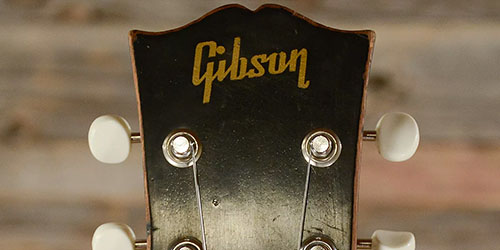
1953 125

1958 Les Paul Custom
1968 to 1972
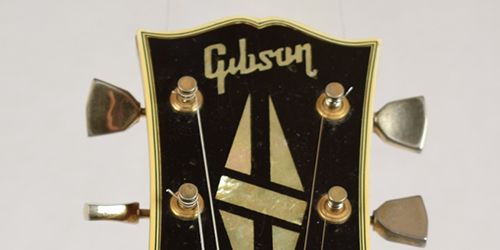
1969 SG Custom
Gibson stopped dotting the i in their logo on some of their instruments. Most models get a dotted i again in 1972, with the rest following suit from 1981 onward.
Other Date-Linked Features
Aside from the logos, each era of manufacturing included certain identifying traits such as the hardware (tuners, knobs, plates, etc.), the pickups, the type of finish, and the electronics inside that can give clues as to when an instrument was made. But not a final verdict.
Many older instruments may have reproduction or other non-original parts, including a non-original finish. This makes relying entirely on the physical features of a guitar potentially misleading.
The thickness of the headstock, however, is not as vulnerable to modification or replacement. Before mid-1950, most Gibson headstocks were thinner at the top when looked at from a side profile. After 1950, headstocks had uniform thickness.
Dating Gibson Vintage Electric Guitars 1952-1961
Early Gibson solidbody electric guitars received a serial stamp on the back of the headstock, with the first number indicating the year of production. The serial number on this Les Paul Junior indicates that it was made in 1956.
1961-1969
Starting in 1961, Gibson implemented a new serialization system designed to cover its entire lineup. However, while the intent was to maintain a more organized catalog, this system in practice achieved the exact opposite.
Numbers from this era were flipped, reused, and in many cases can date an instrument to several non-sequential years. The general system was as follows, though with instruments from this era it’s important to consult key features to get a more accurate age approximation.
Fortunately, Gibson was making more changes to its instruments during the ‘60s and ‘70s than any other period, so dating these instruments by features alone is relatively clear-cut in most cases.
1970-1975
Despite being purchased by the Norlin corporation in 1970, Gibson maintained the same confusing 6-digit serial system through 1975, meaning instruments with the same serial number could be from either the ‘60s or the ‘70s.
Fortunately, there were two notable changes to the entire lineup that occurred during the transition that make differentiating ‘60s and ‘70s Gibsons straightforward.
The Volute: c. 1969-c.1981 - This is the curved hump of raised wood below the tuners where the neck meets the headstock. It reinforces and adds strength.
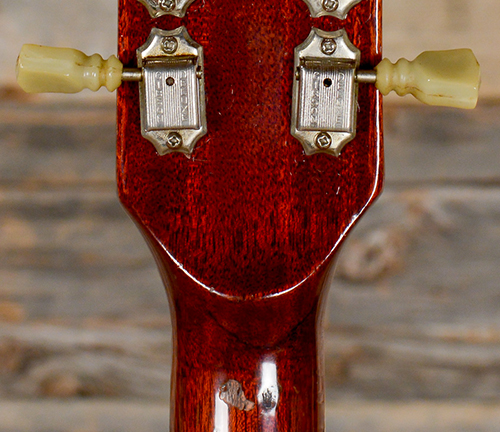
1970 SG Standard
In 1969 Gibson began carving volutes-- small bumps of additional wood where the neck transitions to the headstock-- to cut down on warranty repair work.
"Made in USA" Stamp: 1970-current
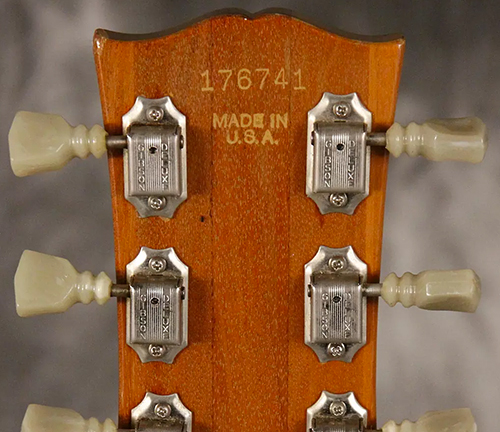
1958 Les Paul Custom
Starting in 1970, ‘Made in USA’ was stamped on the headstock below the serial number.
The serial numbers from this period are generally as follows:
1975-1977
1977-Current
Starting in 1977, Gibson adopted the current date-based serial system which codes for the year and day of production. The first number of the sequence indicates the decade of production, followed by the three digit day of the year, and finally the year.
For example, the serial number 90237XXX corresponds to a production date of 1/23/97. The last three (or four as of 2005) digits signify the location of production and batch number, respectively, but this information isn’t necessary to accurately dating your instrument.
Gibson Serial Numbers 1975-Present
This section is designed to assist in dating and/or identifying instruments manufactured or distributed by Gibson Guitar Corp. Please note that most of this information relates to serial numbers used from 1975 to present.
Gibson USA, Gibson Acoustic, Gibson Memphis
From 1975-1977 the number is typically found on a decal on the back of the headstock. This should be an 8 digit number that can be dated by the 1st and 2nd digits as follows:
99 = 1975
00= 1976
06 = 1977
- In 1977, Gibson introduced the serialization method that we primarily use to this day at Gibson USA, Gibson Acoustic, and the Gibson Custom facility in Memphis, TN.
The serial number will be an 8 digit number impressed into the back of the headstock with "MADE IN USA" below.
The pattern is as follows:
YDDDYRRR
YY is the production year
DDD is the day of the year
RRR is the factory ranking/plant designation number.
Prior to 1984 when the Kalamazoo, MI factory was closed, the numbers 001-499 indicated Kalamazoo production. Ranking numbers 500-999 continued to indicate Nashville production through 1989.
Since 1989, all Gibson acoustics are built in Bozeman, MT and all Gibson electrics are built in Nashville or Memphis. Ranking numbers for Bozeman start each day at 001 and the electrics may start as low as the 300s.
Examples: 70108276 means the instrument was produced on Jan. 10, 1978, in Kalamazoo and was the 276th instrument stamped that day.
82765501 means the instrument was produced on Oct. 3, 1985, in Nashville and was the 1st instrument stamped that day.
NOTE - Gibson USA goes to a 9 digit serial number in early July 2005..
The sixth number is now a batch number- batch 0 starts at the beginning of the day, and once we stamp 699, the batch number will change to 1. The first 5 numbers remain the same, the last 3 numbers will remain the same. The only difference is the addition of this batch indicator.
There are always exceptions to these rules, the two listed below are worth noting:
Les Paul Classic 1989-2014: This model features an ink stamped serial number with no "MADE IN USA" (just as we used on the original 1952-1960 Les Pauls). Most will be 5 to 6 digits in length, but the earliest examples feature 4 digit serial numbers. There should be a space after the 1st digit with the 4 and 5 digit serial numbers, and no space with the 6 digit numbers.
The 1st digit indicates the year of manufacture for the 4 & 5 digit serial numbers, these were used from 1989-1999. The 1st and 2nd indicate the year of manufacture for the 6 digit serial numbers which we've been using since 2000.
Examples -
9 xxx = 1989 (4 digit number beginning with "9" used only in 1989)
0 xxxx = 1990
9 xxxx = 1999
00xxxx = 2000
05xxxx = 2005
*Note – For Les Paul Classics made in 2007 and later, “MADE IN USA” was added to the back of the headstock
Those beginning with "94":
In 1994, Gibson's Centennial year, many instruments have a serial number that begins with "94" for the year, with the remaining 6 digits indicating the ranking number.
Gibson USA 2014 - Mid 2019
These serial numbers cannot be dated to a specific day of the year.
The new model year typically launches in the fall as the current model year winds down. It is not uncommon for a new model year model to be produced during the previous model year (example – a 2015 model may have been built in late 2014).
The pattern is as follows:
YYRRRRRRR
YY is the model year
RRRRRRR is the number in product for the model year (starts at 0000001)
Mid 2019-present
In 2019, Gibson USA reverted back to it’s previous post-2005 scheme, which follows this pattern:
__YDDDYRRRR
YY is the production year
DDD is the day of the year
RRRR is the factory ranking for that day beginning with 0001__
Gibson Custom Shop Serial Numbers
1952-1960 Les Paul, Explorer, Flying V, and Futura reissues (since late 1992):
M YRRR or MYRRRR
M is the model year being reissued
Y is the production year
RRR(R) indicates the guitar's place production for that year. NOTE: This number includes all models for a particular reissue year - so, for example, a 1958 Reissue serial number may include '58 Reissue LP Standard and '58 Explorer production.
Example: 7 5123 is the 123rd 1957 reissue model produced in 2005.
1961-1969 Firebird, Les Paul, and SG reissues (since 1997):
YYRRRM
Y is the production year
RRR(R) indicates the guitar's place in production for that year.
M is the model being reissued
Reissue model codes:
1= SG Custom and Special
2= SG Standard
3= 1963 Firebird 1
4= 1964 Firebird III
5= 1965 Firebird V & VII
8= 1968 Les Paul Custom
Examples: 050102 is the 10th SG Standard reissue produced in 2005.
030084 is the 8th 1964 Firebird III reissue produced in 2003.
Historic ES MODELS (since 1995):
(A or B)-MYRRR
M is the model year being reissued
Y is the production year
RRR indicates the guitar's place in the sequence of Historic ES production for that year.
Reissue model codes:
2= ES-295
3= 1963 ES-335 (block inlays)
4= ES-330
5= ES-345
9 with an "A" prefix = 1959 ES-335 (dot inlays)
9 with a "B" prefix= ES-355
Example: A-38005 is the 5th '63 ES-335 Reissue produced in 1998.
Carved Top models (serial number on orange label)
YDDDYRRR
YY is the production year
DDD is the day of the year
RRR indicate the guitar's place in the sequence of carved tops made that day.
NOTE - as of 2000, 1st digit will be a "2"
Examples:
91418009 is the 9th carved top produced on the 141st day of 1998.
20045002 was the 2nd carved top stamped on the 4th day of 2005.
Custom Shop regular production models
CSYRRRR
CS stands for "Custom Shop"
Y indicates the production year
RRRR indicates the guitar's place in the sequence of production
Example: CS10845 is the 845th reg. production CS model produced in 2001.
CS Signature Models:
The list below is not an exhaustive listing but we have included many of our most popular Signature models. Please contact us at service@gibson.com should you have any questions.
Ace Frehley Les Paul
- 1997 Limited run, numbered in sequence as "ACE xxx"
Note: The discontinued Gibson USA Ace Frehley Signature Les Paul has a standard 8 digit serial number.
Andy Summers ES-335
Limited edition of 50. Numbered in sequence as "AS xxxx"
Dickey Betts '57 goldtop Les Paul
Limited edition of 114. Numbered in sequence as "DB xxx"
Dickey Betts '57 red top Les Paul
Numbered in sequence as "DBR xxx"
Gary Rossington Les Paul
Limited edition of 250. Numbered in sequence as "GR xxx"
Gary Rossington SG
Limited edition of 250. Numbered in sequence as "13xxx"
Jimmy Page Les Paul (3 versions)
-1st 25 aged models were hand numbered 1-25 and signed by Jimmy Page, no other number is on this model.
-Limited run of 150 aged models are numbered in sequence as "PAGE xxx"
-Unlimited run of Custom Authentic models are numbered in sequence as "JPP xxx"
Note: The discontinued Gibson USA Jimmy Page Signature Les Paul has a standard 8 digit serial number.
Joe Perry Les Paul (2 models)
- Joe Perry Signature Les Paul from 1996 (trans black finish) - numbered in sequence as "JPxxx"
- Boneyard LP - Pilot Run models have an inked number and hand written "Pilot Run". The production version (no difference in spec) numbered in sequence as "BONE xxx"
Note: The discontinued Gibson USA Joe Perry Signature Les Paul made has a standard 8 digit serial number.
Johnny A.
Numbered in sequence as "JA xxx"
Pete Townshend LP Deluxe
Limited run of 75, numbered in sequence as "PETE xxx"
Peter Frampton Les Paul (2 models)
- PF LP Custom - numbered in sequence as "PF xxx"
- PF LP Special - numbered in sequence as "PFYxxx" Y indicates the year of production.
Slash Les Paul (2 models)
- 1997 limited edition model, cranberry finish: numbered in sequence as "SL xxx"
- Regular production model introduced in 2004, also numbered in sequence as "SL xxx"
Note: The discontinued Epiphone Slash Les Paul made has a standard Epiphone serial number.
Tony Iommi SG
Numbered in sequence as "TI xxx"
Zakk Wylde Les Paul
Bullseye and the rare "Rough Top" version numbered in sequence as "ZW xxx"
Camo version numbered in sequence as "ZPW xxx"
Gibson Banjos 1988 to present
Earl Scruggs Models
Standard:
Sequential production number, starting at 001
'49 Classic:
YY-RR
YY = Year of manufacture
RR = ranking number (starts at 01)
Golden Deluxe:
YY-RR
YY = Year of manufacture
RR = ranking number (starts at 01)
Flint Hill Special:
FH-YY-RR
YY = Year of manufacture
RR = ranking number (starts at 01)
Special:
ES-YY-RR
YY = Year of manufacture
RR = ranking number (starts at 01)
Style 250
250-TT-RR
YY = Year of manufacture
RR = ranking number (starts at 01)
Granada
YY-MM-RR
YY = Year
MM = Month
RR = ranking number (starts at 01)
RB
RB### = sequential production number
All other models
S(S)-YYMM-RR
S(S) = style (excluding style 250 - see above)
YY = Year
MM = Month
RR = ranking number
Epiphone
Most regular production models since ca. 1993. Many '80s and early '90s serial numbers may follow a similar scheme, but may not include a factory ID code.
FYYMMRRRR
F= Factory code (this can be 2 letters as well)
YY= year of manufacture (this can also be just 1 digit for '90s models)
MM= month of manufacture
R= ranking number (may be more or less digits, not necessarily indicative of total units produced)
Example - S02021234 was issued in Feb. 2002.
Another code used on some current Epiphone models
FYYMRRRR
F= Factory code
YY=Year of manufacture
M= This will be a letter code corresponding to the month (A=January, B=February, etc...)
RRRR= ranking number
Example - R03D0263 was issued in April 2003.
Epiphone Elite/Elitist models
FYSSSS
F= Factory Code (this code will be an "F" or "T")
Y= Year of manufacture (2 = 2002, 3 = 2003, etc.)
SSSS= Sequential Serial Number
Example - T41234 is a 2004 Elitist model.
Dobro (1995-present)
1995-1997
A(A) (#)###YY
A(A) = model code
(#) ### = ranking number
YY = last 2 digits of year
Example - BA xxx 95 dates to 1995
1997-Current
YMMDDRRY
Y = last digit of year
MM = Month
DD = day of month
RR = ranking number
Y (last digit) = decade
Gibson Goldtone Amps
Product code/production number/quarter and year made
Example - G-03/207/299
Note that the "'G" is often mistaken for a "6". This amp was made in the second quarter of 1999.








